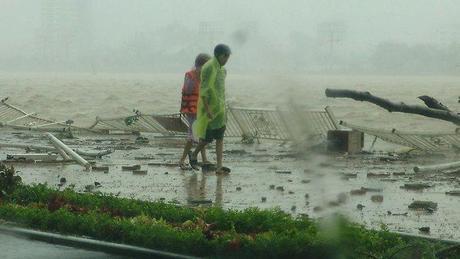from News.com.au
The death toll from a powerful typhoon that lashed Japan’s Pacific coast has jumped to 13 and looks set to rise, police say, after landslides on an island south of Tokyo swept into houses.
“We’ve confirmed that 13 people have died, and the number is likely to increase later,” an Oshima police official told AFP on Wednesday.
Around 38 people were unaccounted for after five houses were destroyed or swept away by a series of landslides and floods on Oshima island, which sits some 120km south of the Japanese capital, according to officials and public broadcaster NHK.
A further three people were missing in the greater Tokyo area, officials and reports said on Wednesday.
Emergency workers had rescued two people who were trapped inside a destroyed house on Wednesday morning, NHK said, adding police and firefighters have not been able to get to many areas.
Typhoon Wipha, described as the “strongest in 10 years”, closes in on Japan on a path that will take it towards the Fukushima nuclear power plant.
The bodies of two of those who died were discovered in a swollen river, while one other was pulled from a crushed house, NHK said.
“City hall and fire station officials are doing rescue work in places accessible,” a local official told AFP.
The local authority has not been able to confirm the whereabouts of 38 of the island’s more than 8300 residents.
It was not known if they were simply unable to make contact or if their situation was more grave.
Live footage showed severe storm damage to the tourist island known for its camellia flowers.
Mud, mangled trees and other debris were piled up around houses, while many local residents had sought shelter in an evacuation centre, reporting dirty water had been gushing into their homes, according to local media.
Tokyo Metropolitan Police is to dispatch about 50 special police officers to the island as reinforcements, Jiji Press said.
In Kanagawa prefecture, south of Tokyo, helicopters were being used to look for two elementary school boys who were believed to have been near a beach during the storm, a police spokesman said.
And fears were growing for the safety of a man in his 50s in Chiba prefecture, who has been missing since telling police there had been a landslide behind his house.
Further north, the operator of the battered Fukushima nuclear plant said it had released some rain water that was trapped inside its barrages, but added that its radiation reading was within safety limits.
It reported no ill effects on the power station, where thousands of tonnes of radiation-polluted water are being stored in tanks after being used to cool reactors.
“We are making preparations for proper management of contaminated water…. We will patrol places that could have inflows of water (from the storm),” a company spokesman said earlier in the day.

People walk along the Han river as Typhoon Nari hits the central coastal city of Da Nang in Vietnam.
Cables and hoses have been bundled together, while ground and off-shore works have been halted, he said.
Earlier this month the company announced 430 litres of polluted water had spilt from a tank as workers tried to remove rainwater dumped at the plant by recent typhoons.
It has admitted contaminated water may well have flowed into the sea.
Japan’s atomic watchdog summoned the president of TEPCO for a public dressing-down for sloppy standards at the plant after the incident.
The nuclear plant was badly damaged by the tsunami that hit in March 2011.
Critics say it remains in a fragile state and at the mercy of extreme weather or other natural hazards.
Typhoon Wipha, which had not made landfall, brought heavy rains and strong winds to Tokyo’s metropolitan area, heavily disrupting the morning commute for hundreds of thousands of people.
The Japan Meteorological Agency said Wipha was moving northeast, gradually shifting away from Japan.
Tokyo and surrounding areas were hit by violent winds and heavy rains in the early hours of this morning as Typhoon Wipha moved northeast off the coast of central Japan.
Thousands were evacuated from their homes in the neighbouring prefecture Chiba and power outages were reported.
The weather bureau warned the typhoon could make landfall in the densely populated Kanto region, which includes Tokyo, later in the morning.
Typhoon Wipha, packing winds of nearly 200km/h near its centre, was moving northeast at around 55km/h in the early hours of the morning, Kyodo said.
The typhoon was forecast to be off the coast of Fukushima later in the day, where the crippled nuclear power plant sits, with the area already experiencing heavy rainfall on Tuesday.
“It is the strongest typhoon in 10 years to pass the Kanto region (Tokyo and its vicinity),” Hiroyuki Uchida, the weather agency’s chief forecaster, told a news conference on Tuesday.
“It is expected to have a great impact on the traffic systems in the metropolitan area during commuting hours,” he said.
Japanese airlines announced the cancellation of 500 flights on Wednesday, while 30 high-speed trains and 100 other trains were cancelled, rail companies said.
Automaker Nissan said it had told employees across Kanto to stay at home for the morning to ride out the storm. Schools have also asked students to stay at home.

